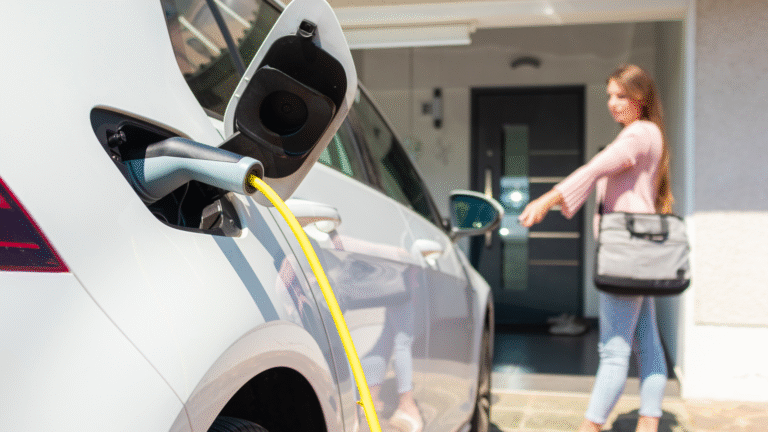Electric vehicles (EVs) have come a long way—from simply driving clean to powering your home. Thanks to bidirectional charging, Aussie EV owners are now able to use their car batteries not just for transport, but as backup power sources or part of a smart home energy solution.
As Australia embraces renewable energy and the National Electricity Market (NEM) modernises, bidirectional charging positions your EV as both a vehicle and a power asset. Let’s explore how it works, what’s available locally, and what you need to power your home with your EV.
—
Table of Contents
- What Is Bidirectional Charging?
- The Three Types: V2G, V2H, and V2L Explained
- Benefits of Powering Your Home with an EV
- Compatible EVs and Chargers in Australia
- Key Considerations and Setup Costs
- FAQs
- Conclusion
—
1. What Is Bidirectional Charging?
Bidirectional charging allows electricity to flow both ways: from the grid into your EV, and from your EV back into the home or grid.
This means your EV battery can be used for:
- Supplying electricity to your home during a blackout (Vehicle-to-Home, or V2H)
- Supporting the electricity grid (Vehicle-to-Grid, or V2G)
- Powering devices and appliances directly (Vehicle-to-Load, or V2L)
Think of it as turning your car into a giant mobile battery pack—a perfect partner for solar systems and off-grid setups in Australia.
—
2. The Three Types: V2G, V2H, and V2L Explained
| Type | Description | Use Case in Australia |
|---|---|---|
| V2G (Vehicle-to-Grid) | Sends energy back to the grid | Offset peak demand and earn credits |
| V2H (Vehicle-to-Home) | Powers your home directly | Backup power during outages, energy savings |
| V2L (Vehicle-to-Load) | Powers external devices/appliances | Camping, off-grid work, mobile charging |
📌 V2H and V2G require a bidirectional charger and installation by a certified technician.
📌 V2L is available in many newer EVs with a simple plug adapter—no installation required.
—
3. Benefits of Powering Your Home with an EV
🔌 Emergency Backup Power
Keep the lights on during blackouts or storms—perfect for regions like rural Victoria or northern Queensland where outages are more common.
🌞 Pair With Solar
Store solar energy during the day and use it at night, maximising self-consumption and reducing your electricity bills.
💰 Energy Cost Savings
Use your EV battery to avoid expensive peak-hour electricity rates by powering your home when grid energy is most costly.
📉 Reduce Grid Strain
Support Australia’s renewable transition by helping stabilise the grid, especially as coal exits and renewables ramp up.
🧳 Off-Grid Capability
Take your EV camping or to remote job sites and power everything from fridges to power tools—ideal for weekend adventurers.
—
4. Compatible EVs and Chargers in Australia
| EV Model | Bidirectional Capability | Notes |
|---|---|---|
| Nissan Leaf | V2G, V2H, V2L (CHAdeMO) | Most widely tested for V2H in AU |
| Mitsubishi Outlander PHEV | V2H, V2L | PHEV with off-grid capability |
| BYD Atto 3 | V2L | Great for powering tools/appliances |
| Hyundai IONIQ 5/6 | V2L (V2G planned) | Ideal for outdoor power needs |
| Kia EV6 | V2L | Includes interior and exterior ports |
Chargers:
- Wallbox Quasar (CHAdeMO, V2H & V2G)
- Delta DC Wallbox
- JetCharge (local Aussie provider supporting pilot V2G installations)
🛠️ Keep in mind: CCS-compatible V2G is still in development, so most current V2H/V2G solutions rely on CHAdeMO.
—
5. Key Considerations and Setup Costs
🧾 Installation Costs
A bidirectional charger for V2H or V2G can cost between $5,000–$10,000 including installation.
⚡ Battery Capacity
You’ll typically be able to power your home for 1–2 days using a fully charged EV battery (40–80 kWh).
📜 Regulatory Approvals
Not all electricity providers in Australia currently support V2G. Check with your DNSP (Distribution Network Service Provider) for local rules.
💡 Smart Energy Management
Pairing your EV with a home energy management system (like Tesla Powerwall or SolarEdge) can help you automate when and how energy flows.
🌏 Incentives
As of 2025, V2G trials and rebates are active in states like NSW, SA, and ACT—keep an eye on Clean Energy Regulator announcements for eligibility.
—
FAQs
🔋 Can I use my EV to power my house in a blackout?
Yes, if your EV supports V2H and you have a compatible bidirectional charger installed.
🌞 Can I use my EV with rooftop solar?
Absolutely. Many Australian households pair EVs with solar to store excess energy and use it after dark.
⚙️ Is bidirectional charging bad for my EV battery?
No, as long as it’s managed correctly. Some manufacturers even warranty V2H/V2G usage.
📶 Will I need Wi-Fi or a smart energy system?
While not essential, a smart system helps optimise when energy is drawn or discharged, saving more money in the long run.
—
Conclusion
Bidirectional charging is a major leap forward in how Australians can use electric vehicles. It’s not just about driving clean—it’s about living smart. From powering your home in a blackout to supporting the national grid, your EV is now an integral part of a sustainable energy future.
🔌 As bidirectional technology rolls out across more models and states, powering your home with your EV is no longer a concept—it’s a powerful reality.
—
Turn your EV into a power source for your home. Discover how bidirectional charging (V2H, V2G, V2L) works in Australia and what EVs support it.
